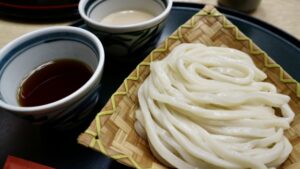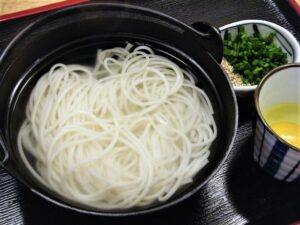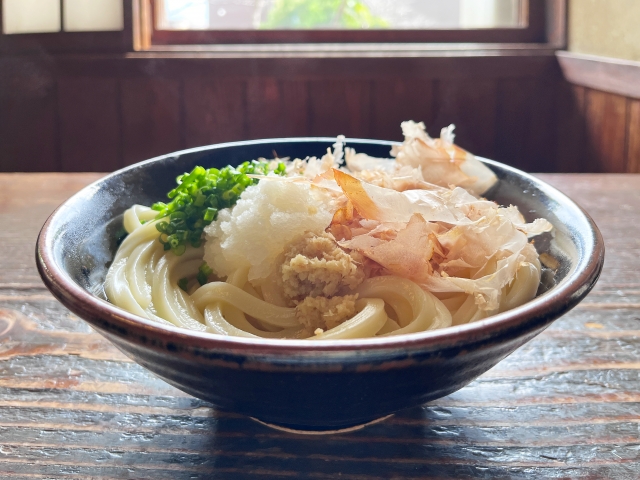For the Japanese people, Udon is one of the most familiar and beloved everyday dishes.
A steaming bowl warms the body on a cold day, while chilled noodles provide refreshing relief in the heat of summer.
Udon has naturally woven itself into daily life across generations.
Because Udon is made from simple ingredients—primarily flour, water, and salt—it reflects the unique climate and culture of each region.
Traveling across Japan reveals a diverse world of local flavors, customs, and preparation styles, making Udon a culinary adventure.
The Origins and Evolution of Udon
Udon’s history dates back approximately 1,300 years to Japan’s Nara period (8th century).
Its roots lie in “konton,” a Chinese dumpling dish introduced to Japan. Initially, it was not a noodle dish but rather a dumpling-like preparation made from kneaded wheat flour.
During the Heian period (794–1185), wheat-based foods became common among the nobility. Over the Kamakura (1185–1333) and Muromachi (1336–1573) periods, the dish gradually evolved into a noodle form resembling modern Udon.
Udon, as we know it today, became widespread among the common people in the Edo period (1603–1868).
In bustling castle towns and post stations, Udon served as a convenient and satisfying meal for travelers and merchants.
This period saw the rise of countless Udon shops across the country.
Over time, each region adapted Udon to its local climate, available ingredients, and cultural preferences, giving birth to a rich variety of styles that continue to this day.
Dashi Broth: The East-West Divide in Taste
One of the key elements that define the flavor of udon is the “dashi” broth.
While noodle texture varies regionally, the broth’s taste reveals the culinary identity of each area.
In Eastern Japan, particularly around Tokyo, dark soy sauce is used, creating a richly colored broth with bold flavors from bonito flakes and dried sardines. This reflects the robust Edo-style food culture that favors stronger seasonings.
In contrast, Western Japan, including Kyoto and Osaka, favors a lighter broth made with kelp and light soy sauce. The result is a pale, elegant soup that highlights the natural flavors of the ingredients—a tradition rooted in the delicate cuisine of Kyoto.
These differences arise not only from the types of soy sauce or dashi ingredients used, but also from variations in water quality, climate, and deeply rooted local food customs.
Tasting the broth offers a glimpse into the culture and daily life of each region.
Regional Udon Varieties Across Japan
All over Japan, you’ll find “local udon” that reflects each region’s lifestyle, ingredients, and traditions.
Here are some representative examples:
Sanuki Udon (Kagawa Prefecture)
Sanuki udon is the soul food of Kagawa Prefecture, so much so that the area is nicknamed “Udon Prefecture.”
Its defining characteristics are firm, chewy noodles with a smooth texture.
In Kagawa, you can customize your udon by choosing from styles such as “kake” (hot broth), “bukkake” (thicker sauce), or “kamatama” (topped with raw egg).
Broths often use dried sardines (iriko) for a light, savory flavor that pairs perfectly with the noodles.

Sanuki udon is renowned throughout Japan. One of its charms is the variety of ways it can be enjoyed.
Inaniwa Udon (Akita Prefecture)
Inaniwa udon hails from Inaniwa town in Akita Prefecture’s southern region. Known for its thin, smooth hand-stretched noodles, it has a history spanning over 350 years.
During the Edo period, it was so prized that it was presented as tribute to feudal lords.
Making Inaniwa udon involves repeatedly kneading the dough and stretching it by hand—a delicate process requiring great skill.
The result is silky noodles often served chilled, making them a popular summer gift. The finished product is as beautiful as it is delicious.

Inaniwa udon, one of Japan’s three most famous types of udon, is known for its delicate thin noodles and smooth, refined texture.
Mizusawa Udon (Gunma Prefecture)
One of Japan’s three great udon varieties, Mizusawa udon originates from the area around Mizusawa Kannon Temple near Ikaho Onsen in Gunma Prefecture. Its history stretches back over 400 years, where it was served as part of Buddhist vegetarian cuisine for temple visitors and hot spring bathers.
Made with pure water and high-quality flour, Mizusawa udon boasts translucent white noodles with the perfect balance of firmness and smoothness.
It is typically served cold with a choice of rich sesame dipping sauce or sweet soy-based sauce. Many shops allow you to try both.
The temple town retains its old-world charm, and enjoying Mizusawa udon here is often a highlight of any visit to Ikaho.

Mizusawa udon, typically served on a bamboo tray, is traditionally enjoyed with sesame or soy-based dipping sauces — a local favorite.”
Ise Udon (Mie Prefecture)
Ise udon is a beloved specialty of Ise City in Mie Prefecture, home to the sacred Ise Jingu, Japan’s most important Shinto shrine.
This unique udon features extra-thick, soft noodles served with a rich soy-based sauce instead of broth.
Though it looks intense, the sauce is mellow and full of umami, providing a comforting taste.
The softness of the noodles is said to have developed historically to aid digestion for weary pilgrims visiting the shrine, offering a heartfelt welcome to travelers.
Simple yet distinctive, Ise udon reflects the warmth and hospitality of the Ise region and remains a treasured dish among locals and visitors alike.

Softly boiled noodles paired with a rich tamari soy sauce — a bowl that captures the spirit of Ise’s local culture.
Goto Udon (Nagasaki Prefecture)
Goto udon has been made for centuries on the Goto Islands of Nagasaki Prefecture. These thin noodles are surprisingly resilient, with a firm bite and smooth finish.
They are coated with camellia oil during the drying process, which enhances preservation and prevents sticking—important qualities for island life with limited supply chains.
A local favorite way to enjoy them is “jigoku-daki” (“hell-boiled”), where freshly boiled noodles are dipped into hot broth with various toppings.
The rising steam and hearty flavors capture the spirit of Goto’s rugged nature and resilient people.
Through centuries of refinement, Goto udon remains an essential part of the region’s food culture.

Jigoku-daki,’ a traditional way of enjoying Goto udon, involves dipping the noodles into boiling hot broth right before eating.
A Living Tradition
Japan’s udon culture showcases how a simple dish can embody the diversity of local climates, traditions, and craftsmanship.
Today, regional udon varieties are enjoyed nationwide through travel, food fairs, and online shopping. Even internationally, “Udon” is gaining popularity as part of Japanese cuisine.
While embracing modern tastes and lifestyles, udon continues to preserve its deep-rooted traditions.
It remains a comforting presence in daily life and a delicious ambassador of Japan’s rich culinary heritage.




コメント